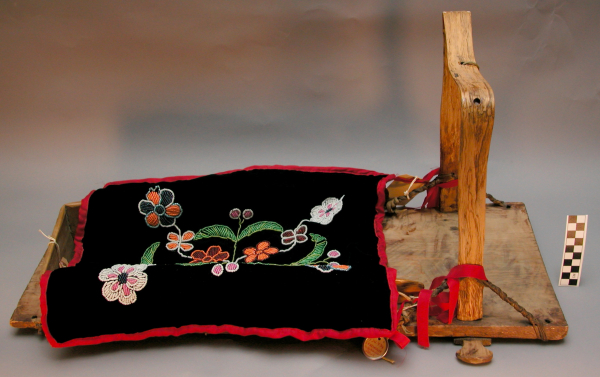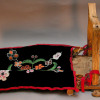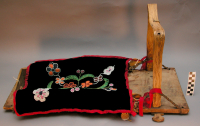tikinaagan
tikinaagan
tikinaagan


This cradleboard is made of a wooden plank and leather strips to fastened the plank to the crossbar and a fabric cover. It has a curve crossbar to protect the baby from being injured if the cradleboard falls. Its exterior is made from blue velvet material, red bias tape, and multicolour glass beads.
A gift.
Part of the Algonquian language family: Potawatomi, Ojibwe, Menomini, Winnebago,
Peabody Museum's records.
Read More About This Relative
Wood, Leather, Fabric, Bias-tape, Glass beads
Here are the following steps to make a cradleboard. First, the artist has to process the tree into a flat board and wooden strips. Secondly, the strips are soaked in hot water or steamed so she or he can bend it into a crossbar and a wooden frame. Finally, the crossbar, frame, and plank are attached with sinew, glue, or nails. Then, the women would make the cradleboard's covering with fabric, glass beads, and bias tape.
The image on the black velvet covering consists of beaded geranium flowers, leaves, tiny gypsophila (baby's breath), and curved stems. Red bias tape is sewn on the edge of the covering, the wooden crossbar is slender, and it has a double curve. Sinew fastens the crossbar to the cradleboard.
The floral images and the tiny gypsophila, aka baby's breaths, are symbolic. The floral images honour the procreation, and the baby' s breaths indicate the infant's arrival.
Traditionally, the cradleboard served multiple purposes. Its primary purpose was to safely carry the baby on the mother's back while she worked or moved from one camp to another. Both mother and baby would accompany each other while harvesting berries and medicine. The baby was laced into the cradleboard under a protective covering. This protected the baby from the underbrush and insects. Its secondary purpose was childcare. The cradleboard was used to keep the baby near the mother and was usually placed against the trunk of a tree or hung from a branch. From this vantage point, the baby could watch the mother, the environment, social interactions and the animals. The cradleboard is constructed with a crash bar. This handlebar protects the baby from falls. A third benefit was how the cradleboard kept the baby's back and legs straight.
Peabody Museum's records.
Provenance
The cradleboard was sold by a dealer name John Nichols. In 1984, Byron Harvey donated the cradleboard to the President and Fellows of Harvard College. Then, the President of Harvard College gave it to the Peabody Museum of Archaeology and Ethnology.
Peabody Museum's records.
Ethnographic: Classification: Baby Carrier
Peabody Museum of Archaeology and Ethnology, 1984
 Knowledge Sharing Platform
Knowledge Sharing Platform

